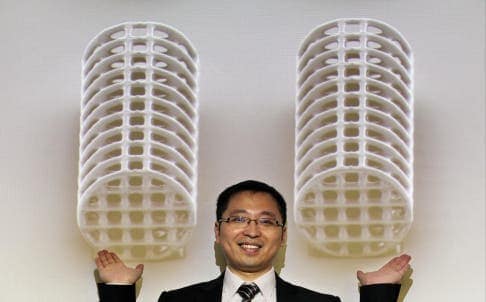
Professor Zhang Li shows enlarged images of his team’s medical microbots that are being tested. Photo: Nora Tam
Researchers at the Chinese University of Hong Kong have developed a new type of microbots approximately the size of a human cell that can carry more targeted drugs than other such options. These can be guided wirelessly through magnetic field manipulation. The Chinese designed microbots as well as other micro or nano-scale alternatives are meant to funnel key substances for non-invasive treatments that otherwise today can only be performed using risky surgery.
Resembling a cage, the microbots are 100 microns long and 40 wide, and are small enough to be injected into the body without leaving a wound. The mirobots are coated with a thin layer of nickel which makes them magnetic and thus can be guided by a magnetic field. The key innovation here is that these micro-containers are larger than other alternatives and can carry more drugs making treatments more effective.
The truck of microbots
“A microbot is like a vehicle that ships drugs directly to the affected area. And I want to design a truck, not a car,” said Zhang Li, assistant professor in the university’s mechanical engineering department. He has been working on microbot technology for seven years.
By modifying the shape of other drug-delivery bots, Zhang and colleagues reached a design capable of carrying more drugs. Preliminary tests show these are indeed biocompatible after the team cultivated human kidney cells in the microbot model. These cells grew and even interacted with the model. So far, the researchers are testing their microbots with mice and rabbits, but Zhang warns that we might be decades away from seeing this work implemented with humans. Safety is a huge concern, and it’s enough for a few or even one of these cage-like bots to stray away from its target destination to become a health hazard.
“Tracking the microbot is a huge challenge. It will be very dangerous if we lose track of the model after injecting it into a human body,” Zhang said.
[NOW READ] Nanorobots made out of DNA seek and kill cancer cells









